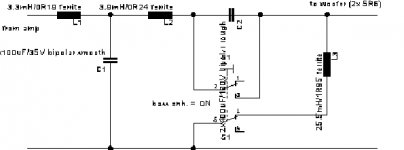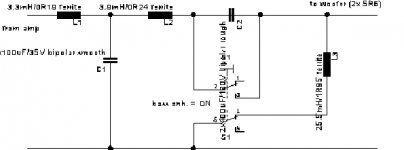Ok, let's hope my picture is readable. L1, L2 and C1 form a classic 3rd order lowpass.
When the bass enhancement is activated, C2 is in series and L3 in parallel. This is actually another lowpass, so it cuts very low bass. I have not done the calculation, but I assume that C2 and L3 also result in a resonant enhancement, so weaker low bass is traded for stronger medium bass, right?
I have been using the bass enhancement for 5 years and never really tested the other setting for more than a few minutes. Having recognized that low base is cut and that another nasty cap is in the signal path, I switched back to the other sitting yesterday and am currently trying to decide if I like this better.
When the bass enhancement is activated, C2 is in series and L3 in parallel. This is actually another lowpass, so it cuts very low bass. I have not done the calculation, but I assume that C2 and L3 also result in a resonant enhancement, so weaker low bass is traded for stronger medium bass, right?
I have been using the bass enhancement for 5 years and never really tested the other setting for more than a few minutes. Having recognized that low base is cut and that another nasty cap is in the signal path, I switched back to the other sitting yesterday and am currently trying to decide if I like this better.
assuming bass enhancement is off...
...there is one shunt capacitor and e two ferrite inductors to deal with.
I think I am going to try using back-to-back polar caps and DC bias before considering buying film caps.
The inductors have a cylindrical ferrite core that looks like a spool of thread, i.e. it has an H-like cross-section, so the windings are not completely surrounded by ferrite.
CFC10 copper air coil has slightly higher resistance but is prohibitively expensive (70€ per inductor).
At www.intertechnik.de, I came accross I-bar (bar core) coils that have just the right resistance and are reasonably priced (<9E). This seems to be an air coil stuck onto a single straight rectangular sheet iron transformer core element. They claim very low distortion even at high power, 0.01-0.05% typ. third harmonic distortion. Actually, this is the only coil for which I have seen distortion values provided.
I can see that the flux in this material would be relatively low, the core not surrounding the windings a lot.
The question is, how does it compare to a good ferrite core? At Intertechnik, they concede that all ferrites have inferior large signal distortion due to lower saturation magnetization compared to iron materials. But they also claim that some optimized ferrites have superior small signal behavior. They are not clear about the reason, but it seems to be connected both to inductive losses and hysteresis.
They even have a selection table where their ferrite coils always rate for lower distortion than their silicon-iron CI and toroid transformer coils. Unfortunately, the bar cores are not included.
As I use mainly low listening levels, I am wondering whether I should replace my ferrites of unknown material quality with optimized ferrites or i-bar iron inductors.
Puzzled,
Eric
...there is one shunt capacitor and e two ferrite inductors to deal with.
I think I am going to try using back-to-back polar caps and DC bias before considering buying film caps.
The inductors have a cylindrical ferrite core that looks like a spool of thread, i.e. it has an H-like cross-section, so the windings are not completely surrounded by ferrite.
CFC10 copper air coil has slightly higher resistance but is prohibitively expensive (70€ per inductor).
At www.intertechnik.de, I came accross I-bar (bar core) coils that have just the right resistance and are reasonably priced (<9E). This seems to be an air coil stuck onto a single straight rectangular sheet iron transformer core element. They claim very low distortion even at high power, 0.01-0.05% typ. third harmonic distortion. Actually, this is the only coil for which I have seen distortion values provided.
I can see that the flux in this material would be relatively low, the core not surrounding the windings a lot.
The question is, how does it compare to a good ferrite core? At Intertechnik, they concede that all ferrites have inferior large signal distortion due to lower saturation magnetization compared to iron materials. But they also claim that some optimized ferrites have superior small signal behavior. They are not clear about the reason, but it seems to be connected both to inductive losses and hysteresis.
They even have a selection table where their ferrite coils always rate for lower distortion than their silicon-iron CI and toroid transformer coils. Unfortunately, the bar cores are not included.
As I use mainly low listening levels, I am wondering whether I should replace my ferrites of unknown material quality with optimized ferrites or i-bar iron inductors.
Puzzled,
Eric
first listening impressions
Did the simplest tuning test, i.e. deactivate the bass control. To my surprise the midrange, which should not have been influenced at all, profited most, i.e. Gianmaria Testa's voice and guitar on "La valse d'un jour".
I did't have the impression that there was a loss of bass volume. Neither am I sure yet if the bass reaches deeper now or is more clearly defined. I have an overall impression of smoother, clearer midrange and a slightly disjointed bass. Maybe that is due to years of listening to the bass extension.
Will try to get used to this and then switch back for comparison.
As I wrote in the beginning, the extra capacitor and inductor can be regarded as an extra high pass that limit how far down the bass reaches. How does the extension/enhancement work? Is there a resonance in the middle bass region?
Eric
Did the simplest tuning test, i.e. deactivate the bass control. To my surprise the midrange, which should not have been influenced at all, profited most, i.e. Gianmaria Testa's voice and guitar on "La valse d'un jour".
I did't have the impression that there was a loss of bass volume. Neither am I sure yet if the bass reaches deeper now or is more clearly defined. I have an overall impression of smoother, clearer midrange and a slightly disjointed bass. Maybe that is due to years of listening to the bass extension.
Will try to get used to this and then switch back for comparison.
As I wrote in the beginning, the extra capacitor and inductor can be regarded as an extra high pass that limit how far down the bass reaches. How does the extension/enhancement work? Is there a resonance in the middle bass region?
Eric
Hi Eric
I answer in this thread since it matches the subject better than within the DF thread.
If it was my speaker to be turned into active, I would either make it three-way active or also make the active separtion between mid and low for the following two reasons:
1.) The power distribution between the amplifiers would be more even. What would you want to drive actively in the mid/high section anyway, the tweeter ? If you want to drive the tweeter AND the midrange actively then you would end up with a three-way active solution unavoidably.
2.) If you want to upgrade the passive part that is left over then it would definitely be cheaper for the mid/high crossover because it uses the smallest part values of the whole crossover.
I wouldn't mind the altered response due to the increased damping of the woofers that much and just give it a try. The implementation of a simple active crossover wouldn't cost you an arm and a leg, as long as you don't mind the work involved.
I also assume that the increased damping wouldn't make a large difference in the mid/high section. But for the amps there is some relief if they don't have to deliver the whole audio range (IMD!).
Regards
Charles
I answer in this thread since it matches the subject better than within the DF thread.
If it was my speaker to be turned into active, I would either make it three-way active or also make the active separtion between mid and low for the following two reasons:
1.) The power distribution between the amplifiers would be more even. What would you want to drive actively in the mid/high section anyway, the tweeter ? If you want to drive the tweeter AND the midrange actively then you would end up with a three-way active solution unavoidably.
2.) If you want to upgrade the passive part that is left over then it would definitely be cheaper for the mid/high crossover because it uses the smallest part values of the whole crossover.
I wouldn't mind the altered response due to the increased damping of the woofers that much and just give it a try. The implementation of a simple active crossover wouldn't cost you an arm and a leg, as long as you don't mind the work involved.
I also assume that the increased damping wouldn't make a large difference in the mid/high section. But for the amps there is some relief if they don't have to deliver the whole audio range (IMD!).
Regards
Charles
- Status
- Not open for further replies.
- Home
- Loudspeakers
- Multi-Way
- T+A T160E bass XO reverse engineered -> improvements?


